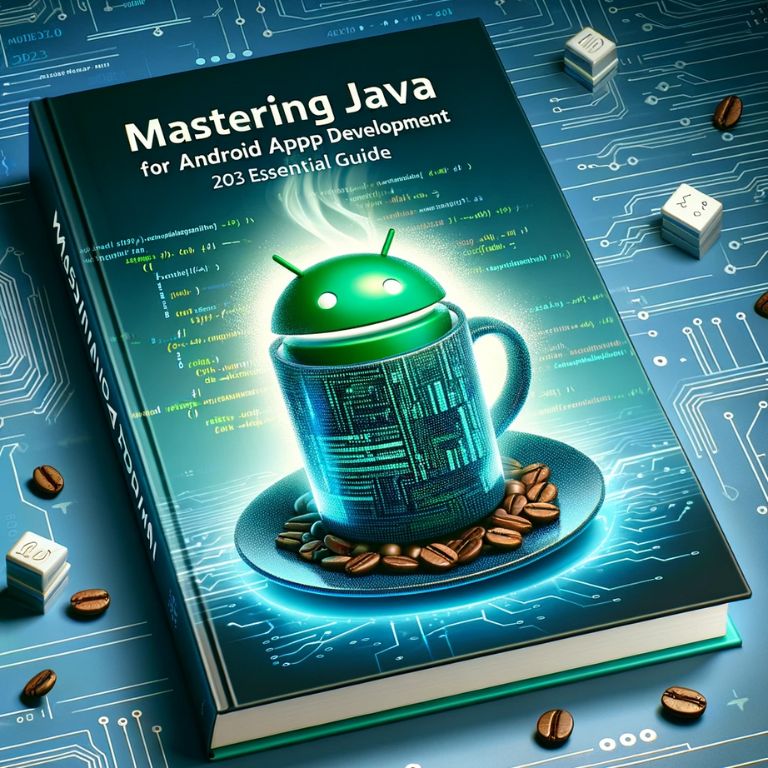Java, one of the most established programming languages, has been a cornerstone in the realm of Android app development. Its robustness, versatility, and widespread adoption have made it a go-to choice for developers aiming to create diverse and dynamic Android applications.
The Foundation of Android Development
Since the inception of Android, Java has been integral to its development environment. This relationship stems from Java’s platform-independent nature, allowing developers to write code that runs on various devices without modification. This feature is particularly crucial for Android, given the vast array of devices running the operating system.
Java’s Role in the Android SDK
The Android Software Development Kit (SDK), which provides the tools and APIs necessary to develop applications on the Android platform, is primarily based on Java. It enables developers to create rich and interactive user interfaces, handle user input, and manage device resources. The SDK leverages Java’s object-oriented programming model, making it easier to structure and maintain complex applications.
Advantages of Java in Android Development
- Object-Oriented Programming (OOP): Java’s OOP model simplifies the development process, especially for large and complex applications, by allowing code modularity, reuse, and ease of maintenance.
- Rich Set of Libraries: Java provides an extensive collection of libraries, easing tasks like network operations, data parsing, and graphics rendering, which are essential in Android app development.
- Cross-Platform Compatibility: Java’s write-once-run-anywhere (WORA) principle ensures compatibility across different Android devices, making it a practical choice for a fragmented ecosystem.
- Garbage Collection: Java’s automatic memory management, particularly garbage collection, helps in effective resource management, crucial for mobile applications where resource constraints are common.
- Community and Support: As one of the most popular programming languages, Java benefits from a vast community of developers. This extensive support network offers a wealth of resources, including documentation, forums, and third-party libraries, invaluable for both novice and experienced Android developers.
Challenges and Considerations
While Java remains a prominent player in Android app development, it’s not without its challenges. The primary concern is performance; Java applications tend to be more resource-intensive compared to those written in other languages like Kotlin. Additionally, Java’s verbosity can sometimes lead to longer development times and more complex code management.
Transition to Kotlin
In recent years, Kotlin, a modern programming language running on the Java Virtual Machine (JVM), has emerged as a preferred alternative for Android app development. Google’s endorsement of Kotlin for Android development in 2017 marked a significant shift, offering developers an option that combines Java’s robustness with modern language features. Kotlin’s concise syntax, null safety, and interoperability with Java have made it an increasingly popular choice.
The Rise of Kotlin for Android Development
Kotlin, a modern programming language developed by JetBrains, has significantly influenced Android app development. Its introduction and subsequent endorsement by Google as an official language for Android development mark a pivotal shift in the landscape, offering a contemporary alternative to Java.
Kotlin’s Interoperability with Java
One of Kotlin’s most notable features is its seamless interoperability with Java. This compatibility means that developers can use both Java and Kotlin within the same project, allowing a smooth transition and the integration of new Kotlin code into existing Java applications. For instance, a developer can call Kotlin functions from Java code and vice versa, providing a flexible and efficient development environment.
Java Example:
public class HelloWorld {
public static void main(String args[]) {
System.out.println("Hello, world!");
}
}
Kotlin Equivalent:
fun main(args: Array<String>) {
println("Hello, world!")
}
This interoperability is vital for gradual migration to Kotlin, where teams can update parts of an application without the need to overhaul the entire codebase.
Advantages of Kotlin in Android Development
- Concise Syntax: Kotlin reduces the amount of boilerplate code, making it more concise and readable than Java. This conciseness not only improves developer productivity but also reduces the likelihood of bugs and errors.
- Null Safety: Kotlin’s type system is designed to eliminate null pointer exceptions, a common source of runtime crashes in Java applications. This feature ensures a higher level of safety and reliability.
- Modern Language Features: Kotlin introduces several modern programming concepts that are absent in Java, such as extension functions, higher-order functions, and default arguments, enhancing the developer’s ability to write expressive and efficient code.
Kotlin’s Impact on the Android Ecosystem
Kotlin’s growing popularity has led to the development of numerous Kotlin-specific libraries and frameworks, further enriching the Android development ecosystem. Additionally, the Android developer community has rapidly adopted Kotlin, with an increasing number of Android applications being either written or migrated to Kotlin.
Google’s Support for Kotlin
Google’s official support for Kotlin in Android development signifies the company’s commitment to modernizing the development experience. The Android team regularly releases Kotlin-specific updates and extensions, such as Kotlin coroutines for asynchronous programming, significantly improving the process of building Android applications.
The Future of Kotlin in Android
As Kotlin continues to evolve with features tailored for Android development, it’s increasingly becoming the preferred choice for many developers. Its modern syntax, robust tooling, and strong community support position it as a key player in shaping the future of Android app development.
Reactive Programming with Java: Enhancing Responsiveness

Reactive Programming in Java has revolutionized the way developers approach asynchronous programming and data flow in applications. This paradigm shift focuses on building non-blocking, event-driven applications capable of handling a large number of concurrent operations efficiently.
Understanding Reactive Streams in Java
Reactive programming in Java is implemented using the Reactive Streams API, which adheres to a publisher-subscriber model. This model allows applications to react to changes in data and propagate these changes through a stream of data.
Java Sample for Reactive Streams:
Flow.Publisher<Integer> publisher = (Flow.Subscriber<? super Integer> subscriber) -> {
subscriber.onNext(1);
subscriber.onNext(2);
subscriber.onComplete();
};
publisher.subscribe(new Flow.Subscriber<>() {
@Override
public void onSubscribe(Flow.Subscription subscription) {
// Handle subscription
}
@Override
public void onNext(Integer item) {
System.out.println("Received: " + item);
}
@Override
public void onError(Throwable throwable) {
// Handle error
}
@Override
public void onComplete() {
System.out.println("Completed");
}
});
This simple example demonstrates the basic structure of a publisher and subscriber in Java’s Reactive Streams.
Benefits of Reactive Programming in Java
- Enhanced Scalability and Responsiveness: By using non-blocking operations, Java applications can handle more concurrent users and data streams without the overhead of traditional thread-based models.
- Backpressure Support: Reactive Streams provide a mechanism for managing the flow of data between publishers and subscribers, thereby preventing overwhelmed subscribers and ensuring stable data processing.
- Functional Programming Style: Reactive programming encourages a declarative coding style, making code more readable and maintainable.
- Integration with Popular Frameworks: Frameworks like Spring WebFlux integrate reactive programming principles, allowing developers to build reactive RESTful web services using Java.
Reactive Libraries in Java
Libraries such as RxJava and Project Reactor extend the capabilities of Java in the realm of reactive programming. These libraries provide advanced features for composing asynchronous and event-based programs.
RxJava Example:
Observable observable = Observable.just(“Hello”, “Reactive”, “World”);
observable.subscribe(System.out::println, Throwable::printStackTrace, () -> System.out.println(“Completed”));
This RxJava example showcases how a simple observable stream can be created and subscribed to, demonstrating the ease of implementing reactive concepts.
The Role of Reactive Programming in Modern Java Applications
In today’s high-performance application environments, where responsiveness and scalability are paramount, reactive programming has become a critical tool. It allows Java developers to build more efficient and resilient applications, particularly for cloud-based and microservices architectures.
Reactive programming in Java represents a significant advancement in the way developers handle asynchronous operations and data streams. Its adoption is driven by the need for more efficient and responsive applications, particularly in the context of large-scale, cloud-native environments. With its focus on non-blocking operations and data flow management, reactive programming is an essential skill for modern Java developers.
Java Module System: Modularization and Maintainability
The introduction of the Java Module System with Java 9 brought a significant shift in how Java applications are structured and managed. This system enhances the modularity, maintainability, and performance of Java applications, particularly beneficial in large-scale projects.
The Java Platform Module System (JPMS)
JPMS allows developers to define modules, encapsulating a group of related packages and resources. This modularization helps in managing dependencies more effectively and provides better encapsulation of code.
Java Module Declaration Example:
module com.example.myapp {
requires java.sql;
exports com.example.myapp.api;
}
In this example, a module named com.example.myapp is defined. It requires java.sql and exports the com.example.myapp.api package.
Key Benefits of the Java Module System
- Improved Application Performance: By allowing applications to only load the necessary modules at runtime, the Java Module System can reduce memory footprint and startup time.
- Enhanced Security and Maintainability: Modules provide strong encapsulation, hiding internal implementation details from other modules. This encapsulation leads to improved security and easier maintenance.
- Dependency Management: The module system provides explicit dependencies, making it easier to understand and manage the relationships between different parts of an application.
Practical Application of the Java Module System
The use of the Java Module System is particularly advantageous in large and complex applications. It encourages a more organized and maintainable code structure, where changes in one module are less likely to impact others. This structure is crucial for long-term project sustainability and scalability.
Transitioning to the Module System
For existing Java applications, transitioning to the module system requires some effort. Developers need to analyze their codebase, identify logical modules, and refactor the code accordingly. Despite the initial investment, the benefits in terms of maintainability and performance are substantial.
The Java Module System represents a significant advancement in the Java ecosystem, promoting better organization, security, and efficiency in application development. Its ability to enforce strong encapsulation and explicit module dependencies makes it an invaluable tool for building robust and maintainable Java applications.
Incorporating Machine Learning and AI in Java Apps

The integration of Machine Learning (ML) and Artificial Intelligence (AI) in Java applications has opened new horizons in the realm of intelligent computing. Java’s robustness and extensive library ecosystem make it an excellent choice for implementing AI and ML algorithms.
Java Libraries for Machine Learning
A variety of Java libraries have been developed to facilitate the integration of machine learning into applications. Some of these include:
- Deep Learning4J (DL4J): An open-source, distributed deep-learning library for Java and Scala.
- Weka: A collection of machine learning algorithms for data mining tasks.
- Apache Mahout: A scalable machine learning library that offers pre-built algorithms.
Java Sample using Weka:
Instances data = … // load or create Instances data
Classifier cls = new J48(); // a decision tree
cls.buildClassifier(data);
In this example, Weka’s J48, a type of decision tree classifier, is used to build a model based on the given dataset.
Java in AI Development
Java’s platform-independent nature, object-oriented design, and automatic memory management make it a suitable choice for developing AI applications. It provides a stable and scalable environment for complex AI algorithms and large-scale data processing.
Enhancing Java Applications with AI
AI can significantly enhance the functionality of Java applications. For instance, it can be used in:
- Natural Language Processing (NLP): Processing and analyzing human language data.
- Computer Vision: Analyzing and interpreting visual information from the digital images or videos.
Java Sample for NLP using Stanford NLP Library:
Properties props = new Properties();
props.setProperty("annotators", "tokenize, ssplit, pos, lemma, ner, parse, sentiment");
StanfordCoreNLP pipeline = new StanfordCoreNLP(props);
This code initializes the Stanford NLP library with various annotators for processing text.
Challenges and Considerations
While Java offers many advantages for AI and ML development, it’s crucial to consider the performance implications, especially for real-time data processing and large-scale deployments. Optimizing Java applications for efficiency and scalability is key when dealing with intensive AI tasks.
The integration of AI and ML in Java applications represents a significant step forward in building smarter, more efficient software. With the right libraries and approaches, Java developers can unlock powerful capabilities in AI, enhancing the scope and functionality of their applications.
Emerging Trends in Android App Development
The landscape of Android app development is constantly evolving, with new trends and technologies emerging regularly. Staying abreast of these trends is crucial for Java developers looking to create cutting-edge Android applications.
Artificial Intelligence and Machine Learning
The integration of AI and ML into Android apps is more than a trend; it’s a transformation in how apps interact with users. Java developers can use libraries like TensorFlow or DL4J for implementing ML algorithms in their apps.
Java Sample for TensorFlow:
try (Graph g = new Graph()) {
final String value = "Hello from TensorFlow";
try (Tensor t = Tensor.create(value.getBytes("UTF-8"))) {
g.opBuilder("Const", "MyConst")
.setAttr("dtype", t.dataType())
.setAttr("value", t)
.build();
}
}
This snippet demonstrates how to create a simple TensorFlow operation in Java.
Chatbots
Chatbots have become an integral part of customer service and engagement strategies in apps. Java developers can leverage APIs like Dialogflow or Microsoft Bot Framework to integrate conversational interfaces into their applications.
Android Jetpack
Android Jetpack is a suite of libraries and tools that help developers follow best practices, reduce boilerplate code, and write code that works consistently across Android versions and devices.
Java Sample using Android Jetpack (Room Database):
@Entity
public class User {
@PrimaryKey
public int uid;
@ColumnInfo(name = "first_name")
public String firstName;
@ColumnInfo(name = "last_name")
public String lastName;
// ...
}
This code snippet shows a simple entity definition using Room, a part of Android Jetpack.
HealthCare and Productivity Apps
The surge in remote healthcare and productivity tools has been significant. Developers can utilize Java to build apps that track health metrics or improve productivity with features like to-do lists and calendar integrations.
5G Technology
The advent of 5G technology is enabling faster and more reliable internet connections, which opens new possibilities for Java developers to create apps that can leverage increased bandwidth and lower latency.
Blockchain Technology
Blockchain technology in Android apps is gaining traction, especially in sectors like finance and security. Java developers can use blockchain to create secure and decentralized applications.
Augmented and Virtual Reality
AR and VR are transforming the user experience in gaming, education, and more. Java developers can use platforms like ARCore to integrate AR capabilities into their apps.
Foldable Devices
The emergence of foldable devices is prompting developers to consider multi-window support and flexible layouts in their app designs to enhance user experience on these new devices.
These emerging trends in Android app development represent a blend of new technologies and user-centric approaches. Java developers can leverage these trends to create more innovative, efficient, and user-friendly Android applications. Staying updated with these trends is key to building future-ready applications that resonate with users and stand out in the competitive app market.
The Future of Java: Cloud Computing, AI, and Beyond
As the world of technology continues to evolve rapidly, Java is not left behind. Its future, especially in the context of Android app development, is intricately linked with emerging technologies like cloud computing and artificial intelligence (AI).
Cloud Computing and Java
Cloud computing has become a backbone for modern application development and deployment, and Java’s role in this domain is significant. Java’s platform-independent nature makes it ideal for cloud-based applications, which require a high degree of portability.
Java Sample for Cloud Interaction (AWS SDK):
AmazonS3 s3client = AmazonS3ClientBuilder.standard()
.withRegion(Regions.US_EAST_1)
.build();
s3client.putObject("bucket-name", "key", "value");
This snippet demonstrates basic interaction with Amazon S3 storage using the AWS SDK for Java, illustrating how Java can be used for cloud-based operations.
Java and AI Integration
The integration of AI in Java applications is gaining momentum. Java’s robustness and extensive libraries, like Deeplearning4j, make it suitable for AI algorithms, especially in data-intensive environments.
Java Sample for Deeplearning4j:
MultiLayerConfiguration conf = new NeuralNetConfiguration.Builder()
.list()
.layer(0, new DenseLayer.Builder().nIn(numInputs).nOut(numHiddenNodes)
.build())
.layer(1, new OutputLayer.Builder(LossFunctions.LossFunction.NEGATIVELOGLIKELIHOOD)
.activation(Activation.SOFTMAX)
.nIn(numHiddenNodes).nOut(numOutputs).build())
.build();
This example shows how to create a simple neural network configuration using Deeplearning4j, a popular deep learning library for Java.
Java for Mobile and IoT

In the realm of mobile and IoT (Internet of Things), Java continues to play a vital role. The ability of Java to run on a variety of devices makes it a preferred choice for IoT applications, which often require a high level of cross-platform compatibility.
Continuous Java Evolution
Java is continuously evolving, with new updates bringing enhancements and new features. For example, recent updates have introduced features like the vector API and pattern matching, which are designed to improve performance and ease development.
Java Sample for Pattern Matching (Java 14 and above):
if (obj instanceof String s) {
System.out.println(s.toUpperCase());
}
This code snippet uses pattern matching introduced in Java 14, showcasing the language’s ongoing evolution to simplify coding practices.
The Demand for Java Specialists
The demand for Java specialists remains high, with opportunities in various fields like web development, enterprise applications, and mobile app development. This demand is driven by Java’s stability, scalability, and widespread use in the industry.
Key Technologies and Frameworks for Java Developers in 2024
As the Java ecosystem continues to grow and evolve, several key technologies and frameworks have emerged as crucial for Java developers, especially in the context of Android app development.
Spring Framework 6
Spring Framework 6 brings forth advancements in Java development, including support for recent Java features and a reactive programming model.
Java Sample using Spring Framework:
@RestController
public class GreetingController {
@GetMapping("/greeting")
public String greeting() {
return "Hello, World!";
}
}
This example demonstrates a simple REST controller using Spring Boot, showcasing how Java developers can quickly set up web services.
DevOps in Java Development
DevOps practices have become integral in Java development, emphasizing continuous integration and deployment. Tools like Jenkins or Maven are commonly used in Java-based DevOps pipelines.
Java Sample for Maven Build:
<project xmlns="http://maven.apache.org/POM/4.0.0"
xmlns:xsi="http://www.w3.org/2001/XMLSchema-instance"
xsi:schemaLocation="http://maven.apache.org/POM/4.0.0
http://maven.apache.org/xsd/maven-4.0.0.xsd">
<modelVersion>4.0.0</modelVersion>
<groupId>com.example</groupId>
<artifactId>my-app</artifactId>
<version>1.0-SNAPSHOT</version>
</project>
This Maven pom.xml file example is a fundamental part of setting up Java projects for automated builds and dependency management.
Big Data Frameworks
With the growing importance of big data, frameworks like Apache Hadoop and Apache Spark have become crucial for Java developers working in data-intensive environments.
Java Sample using Apache Hadoop:
Configuration conf = new Configuration();
FileSystem fs = FileSystem.get(conf);
Path path = new Path("hdfs://localhost:9000/user/hadoop/file.txt");
if (fs.exists(path)) {
FSDataInputStream inputStream = fs.open(path);
// Read data from path
}
This snippet illustrates basic file system operations in Hadoop, showing how Java is used for big data processing.
Cloud Services
Knowledge of cloud services like AWS, Azure, or Google Cloud Platform is increasingly vital for Java developers, especially for those involved in web and mobile application development.
Java Sample for Google Cloud Storage:
Storage storage = StorageOptions.getDefaultInstance().getService();
BlobId blobId = BlobId.of("bucket", "blob_name");
Blob blob = storage.get(blobId);
String content = new String(blob.getContent());
This example demonstrates how to retrieve data from Google Cloud Storage, a common task in cloud-based Java applications.
Android App Development Trends
Staying current with Android app development trends is essential. This includes understanding the latest updates in Android Studio, the Android SDK, and other relevant tools and libraries.
Java continues to be a versatile and powerful language for various applications, from web services to mobile apps, big data, and cloud computing. Staying updated with these key technologies and frameworks is crucial for Java developers looking to remain competitive and effective in the ever-evolving tech landscape. These tools not only enhance development capabilities but also open new opportunities for innovation and advancement in various sectors.
Conclusion: The Evolving Landscape of Java for Android
Java’s enduring legacy in Android app development is a testament to its resilience and adaptability. It has been a cornerstone since Android’s inception, thanks to its robust features and comprehensive ecosystem. Java’s flexibility is further highlighted by its integration with modern programming paradigms, including reactive programming and machine learning, as well as its compatibility with Kotlin. This adaptability ensures Java’s continued relevance in the face of emerging trends and technological advancements.
Looking forward, Java’s role in Android app development appears set to evolve in tandem with technological progress. Continuous improvements in Java and the Android platform, coupled with advancements in fields like cloud computing and big data, present new opportunities for Java developers. This evolution calls for developers to stay abreast of the latest trends, embrace new technologies, and innovate. Thus, Java not only maintains its significance in the Android ecosystem but also offers a dynamic platform for building future-focused, reliable applications.




